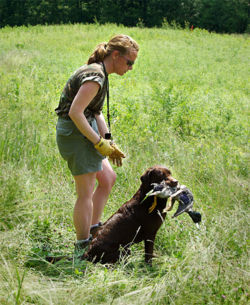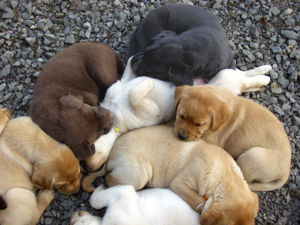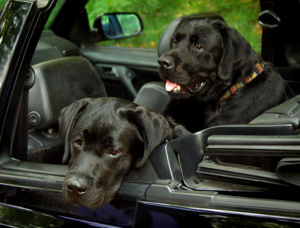Labrador Retriever
The Labrador retriever is the most popular registered breed of dog in both the United Kingdom and the United States, two of the most "dog-friendly" cultures in the world. What about this breed is likely to account for such outstanding popularity? Labradors are generally both exceptionally friendly, and eager to please, making them excellent companions for children, as well as adults. Their intelligence and size also makes them suitable service animals.
Having been bred first to help Newfoundland fishermen haul in their fishing nets and then in Great Britain as 'gun dogs' for hunting waterfowl, Labs are powerful swimmers who love the water. As much as most Labs take to swimming, life on dry land also suits them - as long as there is an opportunity for some exercise. Their ability to adapt to both city and country life is one more factor that accounts for their popularity (ref:SPORTING GROUP: Labrador RetrieversFaith Hyndman. AKC Gazette. New York: Jul 2006. Vol. 123, Iss. 7; p. 51)
History
It is thought to have descended over time from the St. John's Water Dog (no longer in existence), a crossbreed of native water dogs and the Newfoundland dog (to which the Labrador is closely related), through ad-hoc breedings by early settlers in the 17th century.[1]
Breed standards
Common characteristics round the world
Their coats are short and smooth, and they possess a thick, powerful tail that superficially resembles the tail of an otter. The "otter tail" of the Lab is used in swimming and is a characteristic that is specifically selected for in breeding. Other characteristics that are helpful for water retrieving are the dog's water resistant coat and webbed toes.
The otter-like tail and webbed toes of the Labrador retriever make them excellent swimmers. Their interwoven coat is also relatively waterproof, providing more assistance for swimming. The dogs use their tail as rudders to help them steer while swimming. Their short hair allows them to work in icy waters, where longer-hair retrievers would be dragged down by ice clinging to their coats.
Color
There are three officially recognised Lab colors:[2] black (a solid black color), yellow (anything from light cream to gold to fox-red), and chocolate (medium to dark brown). Puppies of all colors may occur in the same litter. The nose of a black or yellow Lab should be black and a chocolate's should be brown, although some fading to pink is permitted. Pink noses without pigmentation is a disqualification.
Variation in type by country, and, within countries, by club
Show dogs (conformation shows)
Field dogs (sporting clubs)
Differences in the physical build of the dog have arisen as a result of specialized breeding. Dogs bred for hunting and field-trial work are selected first for working ability, whereas dogs bred to compete for conformation shows are selected for their closeness to the written breed standard.
There are significant differences between the American field and British show lines. In general, show-bred Labs are heavier, shorter-bodied, with thicker coat and tail. Field Labs are generally longer legged, lighter, and more lithe. In the head, show labs generally have broader heads, better defined stops, and thicker, more powerful necks, while field Labs have somewhat narrower heads with longer muzzles.[3] [4] [5] Field-bred Labs are commonly more energetic and high-strung compared with show-bred Labs. As as a consequence, they may be better suited to working relationships than being just a family pet. [3] [4] [5] Of course, each individual dog differs. Some breeders, especially those specializing in the field type, feel that breed shows do not adequately recognize their type of dog. Talk of officially splitting the breed is also sometimes supported. [6]
Lab nose and skin pigmentation
"Dudley"
Temperament
Working labs
Guide dogs for the Blind
Therapy dogs (other)
"Sniffers" for customs and police work
Health and wellbeing
Labrador life expectancy is generally 12 to 13 years[7], and it generally is a healthy breed with relatively few major problems. Notable issues related to health and wellbeing include:
References
- ↑ http://www.heritage.nf.ca/society/settlement.html
- ↑ The American Kennel Club, Labrador Retriever Breed Standard: "The Labrador Retriever coat colors are black, yellow and chocolate. Any other color or a combination of colors is a disqualification. A small white spot on the chest, called a star, is permissible, but not desirable. White hairs from aging or scarring are not to be misinterpreted as brindling. Black:-Blacks are all black. A black with brindle markings or a black with tan markings is a disqualification. Yellow:-Yellows may range in color from fox-red to light cream, with variations in shading on the ears, back, and underparts of the dog. Chocolate:-Chocolates can vary in shade from light to dark chocolate. Chocolate with brindle or tan markings is a disqualification."
- ↑ 3.0 3.1 http://www.labbies.com/history.htm History of the Labrador Retriever. Retrieved on February 5, 2007.
- ↑ 4.0 4.1 http://www.pineycreeklabradors.com/id20.html
- ↑ 5.0 5.1 http://www.woodhavenlabs.com/english-american.html
- ↑ http://www.woodhavenlabs.com/documents/breed_split2.pdf
- ↑ Fogle, Bruce, DVM (2000). The New Encyclopedia of the Dog. Dorling Kindersley. ISBN 0-7894-6130-7.
Further reading
- Cunliffe, Juliette (2004). The Encyclopedia of Dog Breeds. Parragon Publishing. ISBN 0-7525-8276-3.
- Fergus, Charles (2002). Gun Dog Breeds, a Guide to Spaniels, Retrievers, and Pointing Dogs. Guilford, CT: Lyons Press. ISBN 1-58574-618-5.





